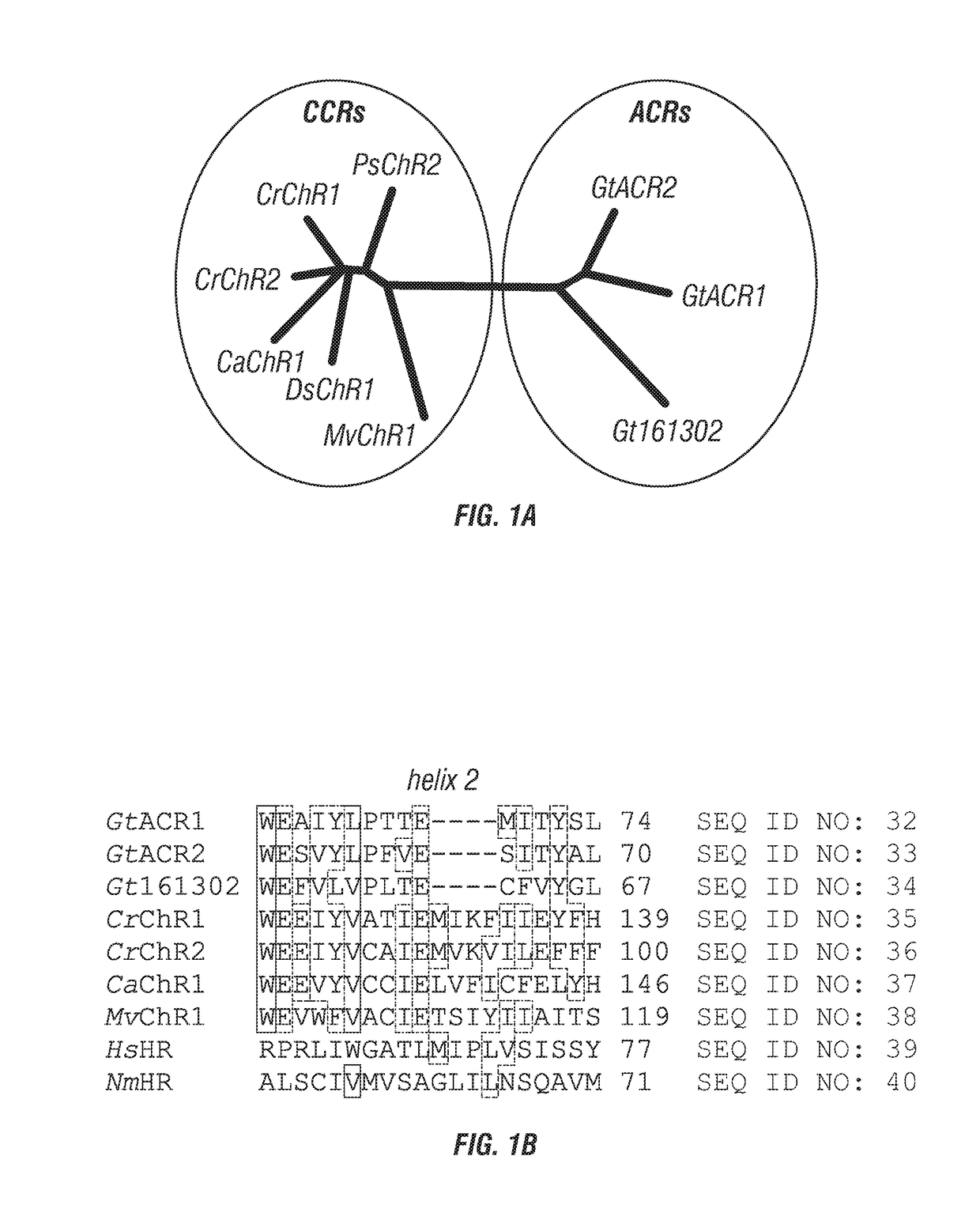Compositions and methods for use of anion channel rhodopsins
a technology anion channel rhodopsin, which is applied in the field of anion channel rhodopsin, can solve the problems of limited photosuppression of neuronal action potentials, and achieve the effects of high-sensitivity and efficient membrane hyperpolarization and neuronal, fast kinetics, and hyperpolarization of the membran
- Summary
- Abstract
- Description
- Claims
- Application Information
AI Technical Summary
Benefits of technology
Problems solved by technology
Method used
Image
Examples
example 1
and Methods
[0219]Molecular Biology Methods:
[0220]Sequences encoding 7TM domains of G. theta opsins (295, 291 and 288 aa, corresponding to the JGI protein models 111593, 146828 and 161302, respectively) were optimized for human codon usage and were synthesized (Genewiz, South Plainfield, N.J., USA) and cloned into the mammalian expression vector pcDNA3.1 (Life Technologies, Grand Island, N.Y., USA) in frame with an EYFP tag. The sequence information encoding the functional constructs 111593 (GtACR1) and 146828 (GtACR2) were deposited in GenBank (accession numbers KP171708 and KP171709, respectively). The gene encoding archaerhodopsin-3 (Arch) was kindly provided by Dr. Edward S. Boyden (Massachusetts Institute of Technology, Boston, Mass., USA). Mutations were introduced using a QuikChange XL site-directed mutagenesis kit (Agilent Technologies, Santa Clara, Calif., USA) and verified by DNA sequencing.
[0221]HEK293 Recording Methods:
[0222]HEK293 (human embryonic kidney) cells were tran...
example 2
ization of Rhodopsins
[0226]Of the approximately 50 known ChRs from chlorophytes, all that have been tested are exclusively cation channels. However, several rhodopsin sequences that have been cloned from these organisms did not exhibit channel activity. The nuclear genome sequence of the cryptophyte Guillardia theta has been completely sequenced (B. A. Curtis et al., Nature 492, 59 (2012)). A BLAST search of model proteins returned 53 hits with homology to microbial (type I) rhodopsins. None were highly homologous to ChRs, but the models of one particular cluster (FIG. 1A) do contain some key residues characteristic of chlorophyte ChRs (FIG. 1B).
[0227]The sequences encoding the 7TM domains of G. theta proteins 111593, 146828 and 161302 were well expressed in HEK293 cells. The first two constructs generated photocurrents, whereas the third did not. As shown below, the first two function as light-gated anion channels; therefore we named them GtACR1 and GtACR2 (Guillardia theta Anion C...
example 3
s a Light-Gated Anion Channel (ACR)
[0236]An additional ACR has been identified in the marine cryptophyte Proteomonas sulcata which shows a close similarity to those ACRs described above that were derived from G. theta. This sequence, has been identified as PsChR1 (see GenBank: KF992074, incorporated herein by reference) and has been shown to generate photocurrents when expressed in cultured neurons (Klapoetke N C, Murata Y, Kim S S, Pulver S R, Birdsey-Benson A, Cho Y K, Morimoto T K, Chuong A S, Carpenter E J, Tian Z, Wang J, Xie Y, Yan Z, Zhang Y, Chow B Y, Surek B, Melkonian M, Jayaraman V, Constantine-Paton M, Wong G K, Boyden E S. Nat Methods. 2014 March; 11(3):338-46)), but these photocurrents were not characterized in detail and the measurements did not distinguish between cationic and anionic conductance. In the example below it is demonstrated that the corresponding P. sulcata protein exhibits light-gated anion conductance similar to that of the ACRs from G. theta, although...
PUM
| Property | Measurement | Unit |
|---|---|---|
| membrane potentials | aaaaa | aaaaa |
| resistances | aaaaa | aaaaa |
| pH | aaaaa | aaaaa |
Abstract
Description
Claims
Application Information
 Login to View More
Login to View More - R&D
- Intellectual Property
- Life Sciences
- Materials
- Tech Scout
- Unparalleled Data Quality
- Higher Quality Content
- 60% Fewer Hallucinations
Browse by: Latest US Patents, China's latest patents, Technical Efficacy Thesaurus, Application Domain, Technology Topic, Popular Technical Reports.
© 2025 PatSnap. All rights reserved.Legal|Privacy policy|Modern Slavery Act Transparency Statement|Sitemap|About US| Contact US: help@patsnap.com



